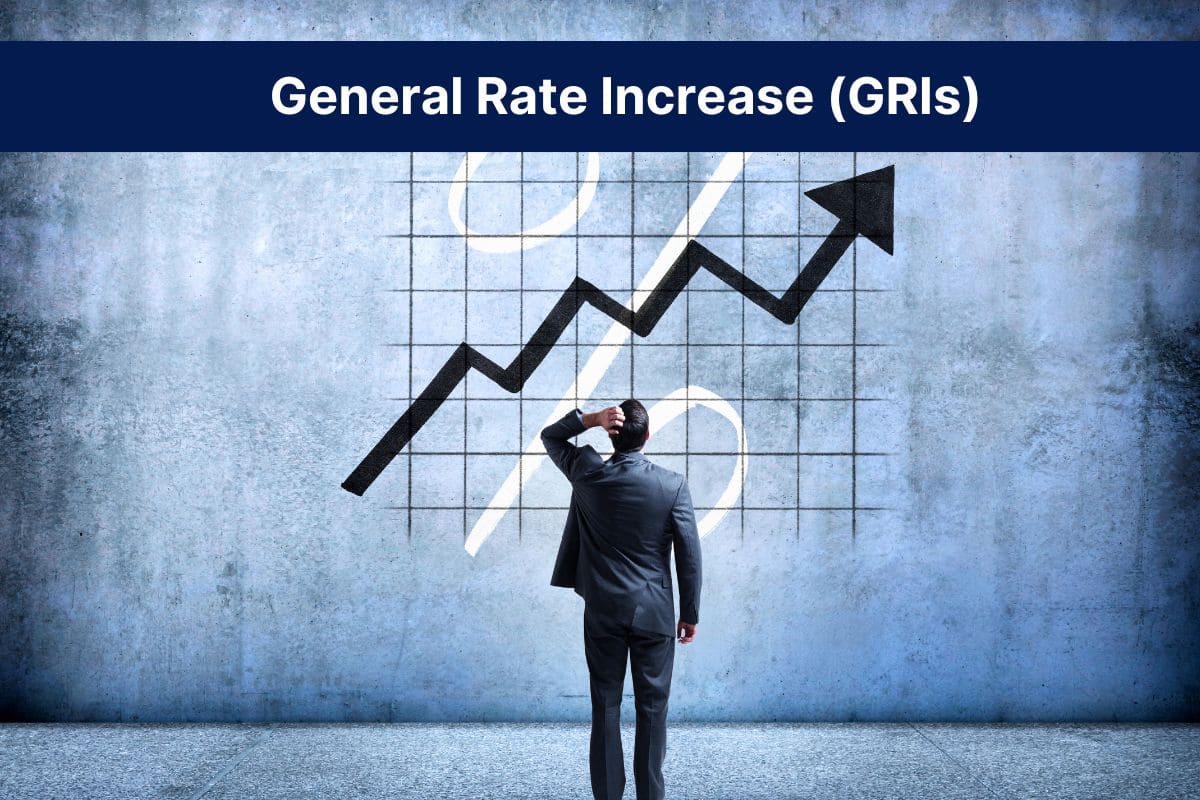What is General Rate Increase (GRI)?
A General Rate Increase (GRI) is when shipping companies raise their base shipping rates to cover rising costs and market changes. It applies to specific trade routes and affects all customers using those routes.
Why Do GRIs Occur?
GRIs happen because shipping costs, like fuel, labor, and available shipping space, can rise. When these costs go up, companies increase rates through GRIs to cover expenses and keep operations running smoothly.
Historical Background and Evolution of GRIs
GRIs have been part of the shipping industry for decades. In the past, GRIs were applied less frequently and were often linked to major cost changes, like spikes in fuel prices. As global trade expanded, so did the complexity of shipping operations. This made GRIs a more regular tool to adjust rates.
In recent years, GRIs have become more common and more targeted. Shipping companies use them to respond quickly to market shifts and changes in operational costs. Today GRIs are announced several times a year and are specific to certain trade routes.
Significant GRI Events
Certain events have triggered major GRIs, reshaping how the industry manages pricing. For example, the 2008 global financial crisis led to sharp drops in demand for shipping services, forcing carriers to adjust their rates frequently. During this period, many companies relied on GRIs to stabilize revenue.
Another key event was the impact of the COVID-19 pandemic in 2020. The sudden rise in e-commerce demand created a shipping bottleneck, leading to a surge in GRIs. Shipping lines raised rates multiple times to manage capacity and meet delivery schedules.
A more recent example is the 2023 labor strike at major US ports. This disrupted supply chains and pushed carriers to apply GRIs to offset increased port fees and labor costs.
These events show how GRIs are not just reactions to cost increases but also change for adapting to sudden changes in the global trade environment.
When and How GRIs are Updated
GRIs are updated based on market conditions. In stable markets, updates might happen once or twice a year. However, in volatile times, they can be applied more often. For example, a sudden fuel price spike or a shipping crisis can lead to unexpected updates. This means businesses must stay alert to sudden rate changes throughout the year.
The duration of a GRI can vary. Some GRIs are temporary, lasting only a few weeks. Others can become the new standard base rate for several months. The length depends on how quickly the market stabilizes. If costs drop, GRIs might be reversed. But if the high costs persist, the GRI could stay in place for a longer period.
Carriers usually announce GRIs about 30 days before they take effect, adjusting rates across specific trade routes. They send an official notice to customers, explaining the new rates and which routes are affected. This early notice gives customers time to adjust their logistics plans. On the effective date, the new rates are applied to all shipments on those routes. Once enforced, the GRI stays until the carrier changes it again based on market conditions.
Factors Influencing GRIs

Several factors drive a General Rate Increase. One major driver is fuel cost. Shipping companies rely heavily on fuel, and even a small change in price can increase overall costs. When fuel prices go up, carriers often use GRIs to recover these expenses.
Another key factor is the balance between supply and demand. If there are more goods to ship than space available, carriers might raise rates. This helps them control capacity and manage demand. On the other hand, if there is extra space and low demand, carriers may delay GRIs.
Operational costs also play a big role. These include expenses like port fees, labor, and equipment maintenance. If these costs rise, carriers will use GRIs to ensure they can cover their operating expenses.
Regulatory changes can also trigger GRIs. New regulations, such as environmental rules, may require carriers to invest in new technology or cleaner fuels. These investments lead to higher costs, which are passed on to customers through rate increases.
Market Conditions and GRI Variability
Market conditions are a key factor in GRI changes. For example, economic slowdowns can reduce demand for shipping. This forces carriers to lower or delay GRIs to attract more business. In contrast, during times of strong economic growth, shipping demand rises. This creates a tight market, which often leads to more frequent GRIs.
Specific trade routes can also see different GRI patterns. For instance, routes that pass through congested ports or high-risk areas might face higher rate increases. Carriers will adjust GRIs based on these local conditions to maintain smooth operations.
Related Surcharges
GRIs are not the only fees that affect shipping costs. There are other surcharges that carriers may add. One example is the Peak Season Surcharge (PSS). This is applied during high-demand periods, like holiday seasons. The PSS helps carriers handle the extra cargo and manage space.
Another common fee is the Emergency Bunker Surcharge (EBS). This is used when fuel prices rise suddenly. The EBS allows carriers to cover the added fuel costs without waiting for a full GRI update.
Impact on LCL and FCL Shipments
GRIs affect both Less-than-Container Load (LCL) and Full Container Load (FCL) shipments, but the impact is different. For LCL shipments, the increase is applied to each cubic meter or weight unit. This means the cost can add up quickly, making LCL shipments more expensive for smaller shippers.
For FCL shipments, the increase is usually a flat rate per container. This means larger shipments may face a bigger absolute cost increase. However, if the container is filled to its capacity, the impact on the per-unit cost of goods is lower compared to LCL.
Impact of GRIs on the Shipping Industry
Importers and Exporters
When a GRI is applied, the base rate goes up. This means importers and exporters need to pay more to move their goods. For small businesses, even a slight increase can affect their profit margins. For larger companies, these costs add up quickly, impacting overall budget planning.
To manage these cost increases, companies often look for ways to offset the impact. One common strategy is to negotiate long-term contracts with carriers. These agreements can lock in stable rates and offer some protection against sudden GRIs. Another option is to explore alternative shipping routes that may not be affected by the same rate hikes. In some cases, businesses can also consider splitting shipments between different carriers to avoid peak GRI periods.
Freight Forwarders and Logistics Providers
Freight forwarders and logistics providers face unique challenges when GRIs are implemented. They often act as the middlemen between carriers and shippers. This means they must manage the expectations of their clients while also dealing with higher costs themselves. When GRIs increase, freight forwarders might struggle to pass these costs on without losing business.
Who is the most affected by GRIs?
The impact of GRIs is felt unevenly across the shipping industry. Small shippers are the most vulnerable. They usually don’t have the volume or bargaining power to negotiate better rates. This means they feel the full effect of GRIs, which can make their shipping costs unpredictable.
Freight forwarders also feel the squeeze, especially those that rely heavily on spot rates. GRIs can make it harder for them to offer competitive pricing to their clients. In highly competitive markets, they may risk losing customers to providers with better rates or more flexibility.
Overall, the parties most affected are those with lower shipping volumes and fewer resources to manage these changes.
While managing GRIs is important, it’s not the only cost factor shippers face. Demurrage and detention fees can arise due to delays in picking up or returning containers, adding unexpected costs to shipping budgets.
How to Mitigate GRIs: Strategies for Importers and Exporters
Businesses can reduce the impact of GRIs by planning shipments around these rate changes. Start by keeping track of when GRIs are typically announced. Many carriers provide updates 30 days before the rate increase takes effect. If possible, schedule shipments before the GRI begins to avoid paying higher costs.
Another strategy is to adjust the volume of shipments. For example, during periods of low demand, shipping more goods at once can secure lower rates.
Negotiation Tactics and Strategic Contracts
Negotiation is key to managing GRIs. Importers and exporters can mitigate this by negotiating long-term contracts with carriers. These contracts lock in stable rates for a set period, providing protection against sudden increases. It’s best to approach these talks with data. Show your shipping volume and reliability. Carriers are more likely to offer discounts if they see you as a steady partner.
Alternative Shipping Methods and Routes
Choosing different shipping methods is another way to reduce GRI impact. For example, if ocean freight rates are high, try air or rail options. While these might seem more expensive, they can be cheaper during peak GRI periods. Rail shipping, for instance, is often less affected by seasonal demand spikes.
Changing trade routes is another option. If one route is experiencing high GRIs due to congestion or high demand, look for less busy lanes.
Frequently Asked Questions
Who announces and implements a GRI?
Carriers are responsible for announcing and implementing GRIs. They adjust the base freight rates on specific shipping routes to respond to changing costs or market conditions. Typically, carriers announce these rate changes at least 30 days before the GRI takes effect to allow customers time to adjust their shipping plans
What is the role of the FMC in regulating GRIs?
The Federal Maritime Commission (FMC) regulates how carriers implement a GRI for U.S. trade routes. By law, carriers must notify the FMC 30 days in advance of any freight price changes that result in increased costs for shippers. This ensures that rate adjustments are transparent and fair.
However, after implementation, carriers have the flexibility to reduce or roll back rates depending on changing market conditions.







